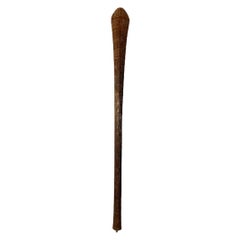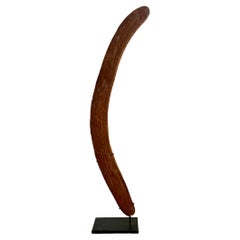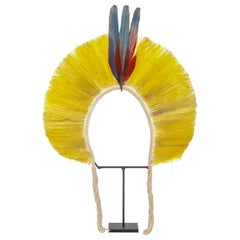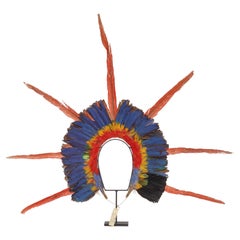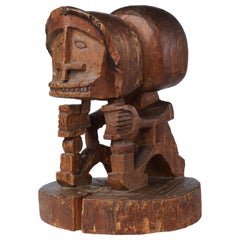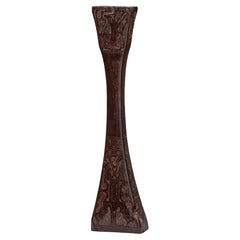Netherlands - Tribal Art
to
1
741
529
57
1
1
6
26
25
18
1
1
23
22
14
13
10
20
20
19
13
12
57
57
57
Item Ships From: Netherlands
Tonga Pakipaki War Club, Polynesia, 18th Century
Located in Delft, NL
A Tonga Pakipaki war club, Polynesia, 18th century
An exceptional ironwood war club originating from Tonga, Polynesia. 18th century and hand carved with complex geometric patterns running the length of the shaft.
4 human and 1 botanical glyphs and a extra carving, see details in picture 2
The Tongan war club...
Category
18th Century Polynesian Antique Netherlands - Tribal Art
Materials
Wood
Australian boomerang, 19th century
Located in 'S-HERTOGENBOSCH, NL
A 19th century boomerang from Australia.
Good patina and presented on a stand.
Category
Late 19th Century Australian Tribal Antique Netherlands - Tribal Art
Materials
Wood
An Amazon Indigenous Kayapo feather headdress
Located in Amsterdam, NL
Brazil, Pará or Mato Grosso, circa 1950’s-1960s
H. 55 x W. 38 cm (incl. stand)
Provenance:
Collection Rinck Hollnberger, Munich
(purchased in the 1980s)
Category
20th Century Brazilian Netherlands - Tribal Art
Materials
String, Feathers
A Kayapo Amazon Indigenous feather headdress
Located in Amsterdam, NL
Brazil, Pará, circa 1950s-1960s
H. 97 x W. 106 cm
Provenance:
Collection Rinck Hollnberger, Munich
(purchased in the 1980s)
Category
20th Century Brazilian Netherlands - Tribal Art
Materials
String, Feathers
Early Papua Korwar Ancestor Figure, Early 19th Century, Deep Black-Brown Patina
Located in Amsterdam, NL
An extremely rare Papua wood sculpture of a Korwar
Papua New Guinea, Cendrawasih Bay, Wandammen, early 19th century
Measures: Height 24 x Diameter 18 cm
Finely carved in th...
Category
Early 19th Century Indonesian Tribal Antique Netherlands - Tribal Art
Materials
Wood
Large Brazilian or Guyana Amazon Indigenous Macana War Club, 18th or Earlier
Located in Amsterdam, NL
A splendid and rare Amazon indigenous wamara wood Macana war-club
Southern-Guyana or Northern Brazil, Wapitxana group of the Aruak peoples, 18th century, possibly earlier
Measure: H. 43 cm
The deep patina of the club present, and the residue on the part where it was held, attest to its great age.
This unusually large Macana is decorated with several incised whitened anthropomorphic and human figures, a decoration only found on one other documented club in the British Museum, which is illustrated in: Hjalmar Stolpe, Amazon Indian...
Category
Early 18th Century Brazilian Antique Netherlands - Tribal Art
Materials
Hardwood
A Sepik 'panggal' sago spathe or tree bark painting of an ancestral figure
Located in Amsterdam, NL
East-Sepik Province, Keram River, early 20th century
The painting in non-binded pigment on sago spathe, bark of a sago palm, depicts an ancestral figure surrounded by a saw fish...
Category
Early 20th Century Papua New Guinean Netherlands - Tribal Art
Materials
Wood
A colourful Yoruba beaded crown
Located in Amsterdam, NL
Yoruba People, Nigeria, 20th century
Provenance:
- Collection Rinck Hollnberger, Munich (purchased in the 1980s or 1990s)
Category
20th Century Nigerian Netherlands - Tribal Art
Materials
Beads
A pair of monkey skull amulets
Located in Amsterdam, NL
Probably Papua New Guinea, or Borneo, Dayak, late 19th/early 20th century
H. approx. 12 cm (incl. stand, each)
Provenance:
Private collection, Flanders
Category
Late 19th Century Papua New Guinean Antique Netherlands - Tribal Art
Materials
Shell, Beads
A delicate tortoiseshell 'armband' from the Lower Sepik River Province
Located in Amsterdam, NL
Sepik River Province, Papua New Guinea, probably late 19th century
Tortoiseshell bracelets are frequently more than just ornaments in Sepik River civilizations; they are representat...
Category
Late 19th Century Papua New Guinean Antique Netherlands - Tribal Art
Materials
Tortoise Shell
A Solomon Islands red feather money coil or 'Tevau'
Located in Amsterdam, NL
Santa Cruz, Nendö, late 19th/early 20th century
Retaining an original leaf in which these coils were wrapped.
L. 72 cm (stretched out)
Diam. 34 cm (roll)
One of the most remarkabl...
Category
Late 19th Century Solomon Islands Antique Netherlands - Tribal Art
Materials
Feathers
A Huli wigman's ceremonial headdress
Located in Amsterdam, NL
Papua New Guinea, Central Highlands, Huli people, 1st half 20th century
Crafted from the wearer’s own hair and adorned with colorful bird-of-paradise feathers, flowers, scarab beetl...
Category
20th Century Papua New Guinean Netherlands - Tribal Art
Materials
Shell, Feathers
18th Century Polynesian Hardwood Ula Tavatava or Throwing War Club from Fiji
Located in Amsterdam, NL
A Polynesian hardwood Ula tavatava or throwing war club
Fiji, probably 18th century
All-over decorated in incised pattern, the bulbous top seems to have a stone grown into it.
H. 42 cm
Including museum-quality powder-coated stand.
Provenance:
Private collection, France
Polynesian culture is traditionally a culture of power and prestige, and there was a fine line between battle and ceremony. Warrior people par excellence, the Fijians had at their disposal a large panoply of weapons, each for a specific use.
The elegant Gata are called gun-sticks by Europeans due to the recognizable form. However, they are designed after a snake, gata in Fijian language. The Ula throwing clubs...
Category
18th Century Fijian Antique Netherlands - Tribal Art
Materials
Hardwood
An Amazon Indigenous Kayapo feather headdress
Located in Amsterdam, NL
Brazil, Pará or Mato Grosso, circa 1950’s-1960s
H. 50.8 x W. 33.5 cm (incl. stand)
Provenance:
Collection Rinck Hollnberger, Munich
(purchased in the 1980s)
Category
20th Century Brazilian Netherlands - Tribal Art
Materials
String, Feathers
A rare Papua 'Gope' Spirit board from the Schulze Westrum collection
Located in Amsterdam, NL
A rare Papua 'Gope' Spirit board from the Schulze Westrum collection
New Guinea, Papua Gulf, probably Urama people, late 19th–early 20th century
Attached to the back are several 'b...
Category
Late 19th Century Papua New Guinean Antique Netherlands - Tribal Art
Materials
Wood
An Asmat ceremonial trophy necklace
Located in Amsterdam, NL
Asmat People, South Papua, Indonesia, probably late 19th century
The Asmat people of Papua are known for creating "trophy necklaces," intricate pieces often made from human bones an...
Category
Late 19th Century Indonesian Antique Netherlands - Tribal Art
Materials
Bone, Natural Fiber
A Maasai throwing club or 'rungu'
Located in Amsterdam, NL
Maasai, African Great Lakes Region, Probably early 20th century
The 'rungu' is a traditional weapon and emblem of authority among the Maasai people of East Africa, especially in Ken...
Category
Early 20th Century Kenyan Netherlands - Tribal Art
Materials
Hardwood
A Naga necklace made of red glass paste beads and bronze trumpets
Located in Amsterdam, NL
Ao tribe, Nagaland, Eastern India, Early 20th century
Made from red glass paste beads and bronze trumpets and bells.
The Ao tribe primarily inhabits the Mokokchung district of Naga...
Category
Early 20th Century Indian Netherlands - Tribal Art
Materials
Bronze
Naga Konyak double fish tail trophy necklace
Located in Amsterdam, NL
Nagaland, North-east India, early 20th century
Made of old glass beads with a bronze adornment in the shape of a double fish tail.
Provenance:
- Collection Rinck Hollnberger, Munic...
Category
19th Century Indian Antique Netherlands - Tribal Art
Materials
Bronze
Polychrome Wood Model of an Indonesian Toraja Dwelling or Tongkonan, C. 1900
Located in Amsterdam, NL
A polychrome wood model of a Toraja dwelling or tongkonan
Indonesia, Sulawesi, Tana Toraja, early 20th century
H. 60 x L. 94 x D. 33 cm
Provenance:
- Seminary Rosa Stichting, Nijmegen
- Instituut voor Kulturele Antropologie van de Katholieke Universiteit, Nijmegen
- With Michel Thieme...
Category
Early 20th Century Indonesian Netherlands - Tribal Art
Materials
Wood
$3,728 Sale Price
20% Off
Two spearheads used as currency by the Bangala people of the Congo
Located in Amsterdam, NL
Democratic Republic of Congo, late 19th century
These spearheads looked like weapons, yet they were hardly ever used in battle. Rather, they functioned as a kind of money that was u...
Category
Late 19th Century Congolese Antique Netherlands - Tribal Art
Materials
Iron
An ancient Papua wooden substitute headhunters's head
Located in Amsterdam, NL
Papua New Guinea, 18th-19th century
L. 22.5 x W. 18 cm (approx.)
Provenance:
Collected by Schulze-Westrum
Collection Rinck Hollnberger, Munich (purchased in the 1980s or 1990s)
For a comparable skull see the collection of the Metropolitan Museum of Art in New York.
The heads of humans and of animals such as crocodiles and pigs formerly played integral roles in the ceremonial life of Papuan Gulf peoples, who considered the heads to be vessels of life-giving supernatural power. Within men’s ceremonial houses, human skulls were displayed, together with sacred images such as spirit boards or gope, by the members of each clan in a specially constructed clan shrine. However, not all heads required the death of an enemy. In some areas, heads made from wood or other materials appear to have had powers equal to actual ones. In contrast to skulls, the facial features of wood heads were sometimes depicted as they appeared in life.
This example comes from the Wapo Creek area, where wood heads appear to have been used interchangeably with actual skulls. When headhunting was abolished by Australian colonial...
Category
19th Century Papua New Guinean Antique Netherlands - Tribal Art
Materials
Wood
A rare Papua 'Gope' Spirit board from the Schulze Westrum collection
Located in Amsterdam, NL
A rare Papua 'Gope' Spirit board from the Schulze Westrum collection
New Guinea, Papua Gulf, probably Urama people, late 19th–early 20th century
H. 114 x W. 27 cm
Provenance:
- Co...
Category
Late 19th Century Papua New Guinean Antique Netherlands - Tribal Art
Materials
Wood
A Polynesian war-club or 'Gata waka'
Located in Amsterdam, NL
Fiji, probably early 20th century
Polynesian culture is traditionally a culture of power and prestige, and there was a fine line between battle and ceremony. Warrior people par exce...
Category
Early 20th Century Fijian Netherlands - Tribal Art
Materials
Hardwood
18th Century Polynesian Ironwood Gata Waka or War Club from Fiji
Located in Amsterdam, NL
A Polynesian ironwood Gata waka or war club
Fiji, probably 18th century or earlier
Measures: Height. 97 cm
Including museum-quality powder-coated stand.
Provenance:
Private collection, France
Polynesian culture is traditionally a culture of power and prestige, and there was a fine line between battle and ceremony. Warrior people par excellence, the Fijians had at their disposal a large panoply of weapons, each for a specific use.
The elegant Gata are called gun-sticks by Europeans due to the recognizable form. However, they are designed after a snake, gata in Fijian language. The Ula throwing clubs...
Category
18th Century Fijian Antique Netherlands - Tribal Art
Materials
Hardwood
A collection of four Ifugao warrior bracelets
Located in Amsterdam, NL
Bontoc or Ifugao people, Northern Luzon, Phillipines, 19th century
The Bontoc and Ifugao peoples of northern Luzon crafted armbands like this one, made from two pairs of wild boar o...
Category
19th Century Philippine Antique Netherlands - Tribal Art
Materials
Rattan, Wood
$16,778 / item
An Illongot headdress
Located in Amsterdam, NL
Ifugao, Northern Philippines, 19th century
Decorated with different kinds of beadwork and the bill of a Kalaw bird (hornbill).
Historically, only those who had proven themselves th...
Category
19th Century Philippine Antique Netherlands - Tribal Art
Materials
Shell, Natural Fiber, Wood, Beads
$2,796
An exquisite warrior's headdress or 'Kaibauk'
Located in Amsterdam, NL
Amarasi district, Kupang regency, West Timor island, early 20th century
Category
Early 20th Century Timorese Netherlands - Tribal Art
Materials
Metal
An Asmat headdress decorated with cassowary feathers
Located in Amsterdam, NL
Asmat, Papua Province, Indonesia, Late 19th century
Provenance:
- Collection Rinck Hollnberger, Munich (purchased in the 1980s or 1990s)
Category
Late 19th Century Indonesian Antique Netherlands - Tribal Art
Materials
Natural Fiber, Feathers
A rare Papua 'Gope' Spirit board from the Schulze Westrum collection
Located in Amsterdam, NL
A rare Papua 'Gope' Spirit board from the Schulze Westrum collection
New Guinea, Papua Gulf, probably Minagoiravi, Wapo River, late 19th–early 20th century
H. 130 x W. 24.5 cm
Pro...
Category
Late 19th Century Papua New Guinean Antique Netherlands - Tribal Art
Materials
Wood
Fine Jelutong Wood Borneo Dayak Kliau or Shield, First Half of the 19th Century
Located in Amsterdam, NL
A fine Jelutong wood Dayak Kliau or shield
Indonesia, Borneo, Kalimantan, first half of the 19th century
Measures: H. 126 x W. 36 cm
The kliau or klebit is the most popular ...
Category
19th Century Indonesian Tribal Antique Netherlands - Tribal Art
Materials
Wood
An elaborate collection of stone tools used by the Mapuche culture
Located in Amsterdam, NL
Mapuche Culture, Southern Chile, Pre-Columbian
A collection of eleven stone tools all varying in sizes.
Category
15th Century and Earlier Chilean Antique Netherlands - Tribal Art
Materials
Stone
African Chief’s gilt Crown and Sceptre in the form of a Pith helmet and pipe
Located in Amsterdam, NL
A splendid Bouelé Chief’s gilt-wood crown and sceptre in the form of a Pith helmet and pipe
Ivory coast, late 19th/early 20th century
H. 13 x L. 33.5 x D. 26 cm (crown)
L. 14 cm ...
Category
Early 1900s Ivorian Antique Netherlands - Tribal Art
Materials
Giltwood
A male ceremonial armband made with bat-teeth
Located in Amsterdam, NL
Papua New Guinea, late 19th/early 20th century
Male ceremonial 'armband' made of bat teeth drilled and tied in a double row to a woven band of palm fibre.
Category
Late 19th Century Papua New Guinean Antique Netherlands - Tribal Art
Materials
Natural Fiber, Beads, Teeth
A monkeytooth bracelet from the Philippines
Located in Amsterdam, NL
Philippines, late 19th/early 20th century
Provenance:
Sammlung Rinck-Hollnberger, Munich (purchased the 1980s-1990s)
Category
Late 19th Century Philippine Antique Netherlands - Tribal Art
Materials
Natural Fiber, Teeth
An Achuar feather headring
Located in Amsterdam, NL
Achuar people, Perú, Amazon region, early 20th century
Category
Early 20th Century Peruvian Netherlands - Tribal Art
Materials
Natural Fiber, Feathers
A Bobo ceremonial top decorated with cowrie shells
Located in Amsterdam, NL
Bobo people, Burkina Faso/Mali, Early 20th century
The top, made in a vest-like form, consists of a base made out of cotton with an outer decorated layer of cowrie shells.
Provenan...
Category
Early 20th Century Burkinabe Netherlands - Tribal Art
Materials
Shell, Cotton
Very rare Melanesian armbands made of woven palm fibers and tiny shells
Located in Amsterdam, NL
Melanesia, Southwestern Pacific Ocean, 19th century
Some very rare Melanesian armbands made of woven palm fibers and tiny shells, dating from the 19th century (at least).
This typ...
Category
19th Century Solomon Islands Antique Netherlands - Tribal Art
Materials
Shell, Natural Fiber
A bridal headdress from Papua called 'ambusap'
Located in Amsterdam, NL
Iatmul, Papua New Guinea, 20th century
This ceremonial headdress is traditionally worn by a young bride as she enters her new husband’s home for the first time. Adorned with shells—...
Category
19th Century Papua New Guinean Antique Netherlands - Tribal Art
Materials
Shell, Natural Fiber
A colourful beaded Yoruba 'crown'
Located in Amsterdam, NL
Yoruba People, Nigeria, 20th century
Provenance:
- Collection Rinck Hollnberger, Munich (purchased in the 1980s or 1990s)
Category
20th Century Nigerian Netherlands - Tribal Art
Materials
Beads
American Diorama, Follower Gerrit Schouten, Carib Indigenous Village
Located in Amsterdam, NL
Follower of Gerrit Schouten (second half of the 19th century)
Diorama depicting a Carib Indigenous camp
Carved wood, papier-mâché, paint on paper...
Category
19th Century Surinamer Antique Netherlands - Tribal Art
Materials
Clay, Twig, Wood, Paper, Feathers
An Anthropomorphic Celt Axe God Pendant
Located in Amsterdam, NL
Central-America, Costa-Rica, Pre-Columbian
Jadeite and other greenstones were utilized in a diverse array of items that served as symbols of social and political power. Among the mo...
Category
15th Century and Earlier Costa Rican Antique Netherlands - Tribal Art
Materials
Stone
An engraved Sepik cassowary bone dagger
Located in Amsterdam, NL
Papua New Guinea, Sepik Region, Abelam people, early 20th century
Bone daggers in the Sepik region are traditionally crafted from the thigh bone of the ca...
Category
Late 19th Century Papua New Guinean Antique Netherlands - Tribal Art
Materials
Bone
Ashanti African Chief’s ceremonial gold and gilt-metal crown and sash on stand
Located in Amsterdam, NL
An Ashanti Chief’s ceremonial gold and gilt-metal crown and sash
Ghana, early 20th century
Diam. 20 cm (crown)
L. 128 cm (sash)
H. 102 cm (incl. st...
Category
Early 20th Century Ghanaian Art Nouveau Netherlands - Tribal Art
Materials
Gold, Gold Plate, Metallic Thread
Two Naga hunting trophy chains
Located in Amsterdam, NL
Nagaland, North-east India, early 20th century
Probably made from dogteeth.
Category
Early 20th Century Indian Netherlands - Tribal Art
Materials
Shell, Beads, Teeth
Cassowary feather Bilum bag from Papua
Located in Amsterdam, NL
Papua New Guinea, early 20th century,
A Bilum bag from Papua New Guinea, crafted from bark fiber and adorned with cassowary feathers.
Provenance:
- Collection Rinck Hollnberger, Mu...
Category
Early 20th Century Papua New Guinean Netherlands - Tribal Art
Materials
Natural Fiber, Feathers
A Baimaru Kundu drum from the Schulze Westrum collection
Located in Amsterdam, NL
New Guinea, Papua Gulf, probably Baimaru people, late 19th–early 20th century
H. 81.5 x Diam. 15 cm.
Provenance:
- Collected by German biologist and cinematographer Thomas Schulze-...
Category
Early 20th Century Papua New Guinean Netherlands - Tribal Art
Materials
Animal Skin, Wood
Early Papua Korwar Statue, Collection of Missionary Starrenburg, Collected 1909
Located in Amsterdam, NL
A Papua wood figure of a Korwar
North West Irian Jaya, Vogelkop area, coastal Geelvink Bay, present-day Cenderawasih Bay, early 20th century
The seated Korwar is holding an ope...
Category
Early 20th Century Indonesian Tribal Netherlands - Tribal Art
Materials
Wood
A Nias 'Adu Zatua' wooden ancestor sculpture
Located in Amsterdam, NL
Indonesia, Nias, 19th century
H. 37.5 x W. 10 cm
Sculptures like the one present are not only decorative items but are believed to be vessels that house the spirits of ancestors and are used to communicate with them.
After the death of a person a wooden image or Adu Zatua was made to mediate between the human world and the spiritual realm. These kinds of figures were commissioned by noble Nias families, whereas simple and lesser quality carvings generally were found among lower class families.
In this particularly fine example, the sculptor has paid careful attention to the proportions of the different parts of the body, dividing it into three main sections – the head, the torso, and the legs. The shapes are sometimes flat, round, or have notches, but all are perfectly in balance creating a certain divine tranquillity. This Adua Zatua’s ears are decorated with earrings, and it is wearing a headdress, pointing towards a chiefly provenance.
In 1914 the Dutch gained complete control of the island of Nias and started spreading Protestant Christianity. Many ancestor statues...
Category
19th Century Indonesian Antique Netherlands - Tribal Art
Materials
Wood
Wabi sabi solid wood "Oromo" stool, Ethiopia 1950s
Located in ECHT, NL
Wabi sabi hand crafted stool. Made by the Oromo people of Ethiopia around the 1950s. Carved from a single piece of hardwood. Skillfully made and highly decorative. The top is made co...
Category
Mid-20th Century Ethiopian Folk Art Netherlands - Tribal Art
Materials
Hardwood
Konyak naga-necklace with brown beads
Located in Amsterdam, NL
Naga Konyak, North-India, early 20th century
The Konyaks, the largest of the Naga ethnic groups, reside primarily in the districts of Tirap, Longding, and Changlang in Arunachal Pra...
Category
Early 20th Century Indian Netherlands - Tribal Art
Materials
Beads
A Mbukushu braided headdress
Located in Amsterdam, NL
Mbukushu / Kavango Group, Botswana/Namibia/Angola, Early 20th century
An exquisite and old example of a Mbukushu braided wig headdress, featuring a leather or hide base that has na...
Category
Early 20th Century Namibian Netherlands - Tribal Art
Materials
Leather, Shell, Natural Fiber
A beautiful beaded from the Bonda people of Orissa
Located in Amsterdam, NL
Bonda people, Orissa, early 20th century
The Bonda people are an indigenous tribal group predominantly found in the hilly areas of Malkangiri district in Odisha (Orissa), India. Recognized as one of the oldest and most traditional tribes in the country, they are often regarded as part of the "Adivasi," or the original inhabitants of the region.
Bonda women are renowned for their distinctive traditional attire and adornments. They wear a minimal garment called nala around their waist and embellish themselves with heavy jewelry crafted from beads, metal, and coins. Their hair is typically styled into a bun and covered with a beaded headpiece...
Category
Early 20th Century Indian Netherlands - Tribal Art
Materials
Metal
A beaded Naga 'Headhunter' trophy necklace
Located in Amsterdam, NL
Nagaland, North-east India, early 20th century
A necklace comprised of glass beads, two dog tooth and a brass face pendant. The four headed pendant symbolises decapitated head-troph...
Category
19th Century Indian Antique Netherlands - Tribal Art
Materials
Brass
A beautiful black-and-white beaded necklace
Located in Amsterdam, NL
Bonda people, Orissa, early 20th century
The Bonda people are an indigenous tribal group predominantly found in the hilly areas of Malkangiri district in Odisha (Orissa), India. Recognized as one of the oldest and most traditional tribes in the country, they are often regarded as part of the "Adivasi," or the original inhabitants of the region.
Bonda women are renowned for their distinctive traditional attire and adornments. They wear a minimal garment called nala around their waist and embellish themselves with heavy jewelry crafted from beads, metal, and coins. Their hair is typically styled into a bun and covered with a beaded headpiece...
Category
Late 19th Century Indian Antique Netherlands - Tribal Art
Materials
Natural Fiber, Beads
An Asmat head ornament made from Cuscus fur
Located in Amsterdam, NL
Asmat, Papua Province, Indonesia, Late 19th century
Made from a long piece of Cuscus fur decorated on the sides with shell beads and strings of natural fiber.
Provenance:
- Collec...
Category
Late 19th Century Indonesian Antique Netherlands - Tribal Art
Materials
Fur, Shell, Natural Fiber
A very colourful beaded necklace
Located in Amsterdam, NL
Bonda people, Orissa, early 20th century
The Bonda people are an indigenous tribal group predominantly found in the hilly areas of Malkangiri district in Odisha (Orissa), India. Recognized as one of the oldest and most traditional tribes in the country, they are often regarded as part of the "Adivasi," or the original inhabitants of the region.
Bonda women are renowned for their distinctive traditional attire and adornments. They wear a minimal garment called nala around their waist and embellish themselves with heavy jewelry crafted from beads, metal, and coins. Their hair is typically styled into a bun and covered with a beaded headpiece...
Category
Early 20th Century Indian Netherlands - Tribal Art
Materials
Metal
Recently Viewed
View AllMore Ways To Browse
African Spear Currency
Ancestor Figure Papua New Guinea
Antique Ethiopian Crosses
Brazil Feather Headdress
Brazil Headdress
Copper African Masks
Dogon Mask
Tribal Crocodile Wood
Wedding Headdress
African Tribal Carved Wood Drum
Amazon Headdress
Asmat Tribal
Dogon Figure
Fiji Club
Fijian War Club
Gelede Mask
Kuba Beaded
Mali Doors
